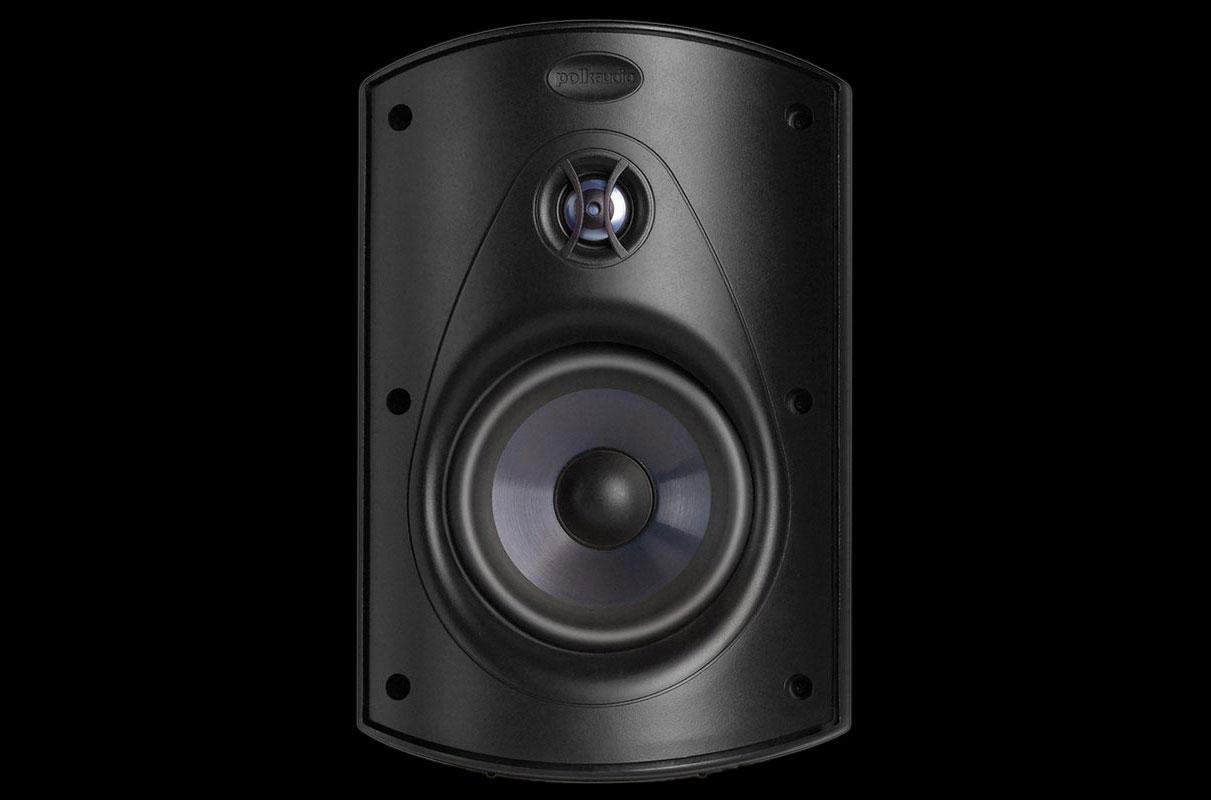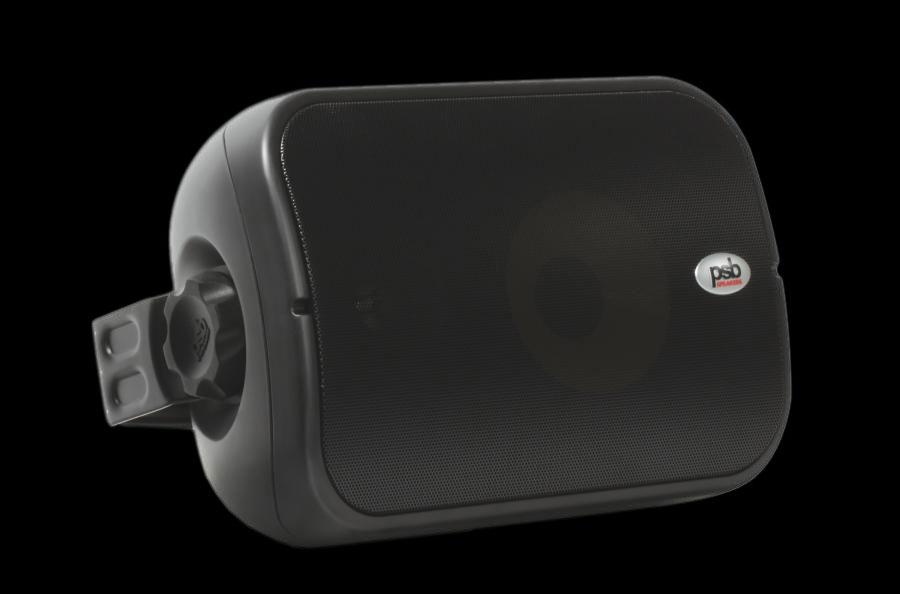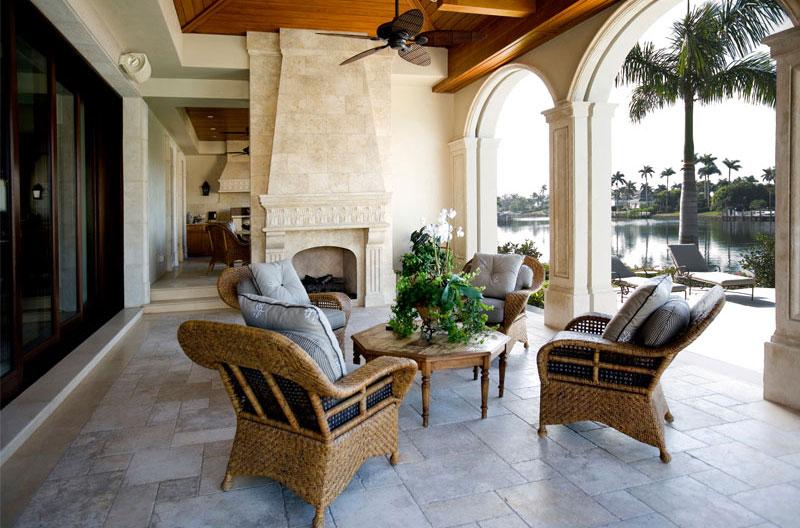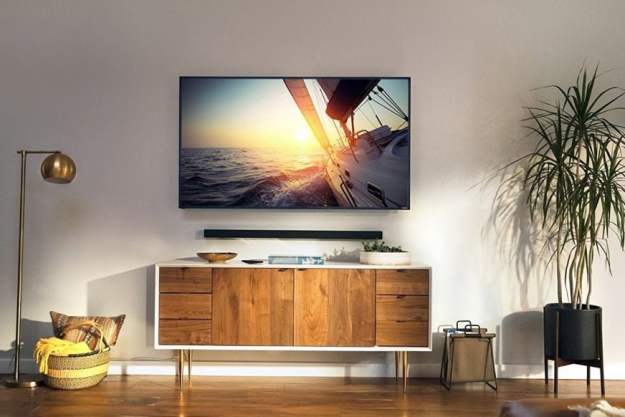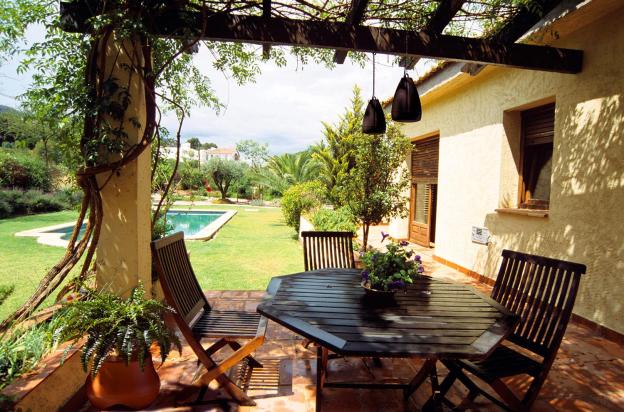
The kids are out of school, the lawn is under control, and the BBQ is ready to feed a never-ending flow of unexpected relatives and friends. You’re ready for summer. But wouldn’t you like to kick it up a notch or two this year? How about throwing some outdoor speakers into the mix? You summer needs a soundtrack and, besides, what better way to drown out Aunt Thelma while she humiliates you in front of the kids with stories about those awkward childhood misadventures?
Sure, you could roll with a small portable wireless speaker like the Definitive Technology Sound Cylinder or go green with something like the solar-powered Eton Rukus Solar, but we think those are best left for road trips and campouts. If you really want to throw down the backyard party, or if you’ve considered putting together an outdoor movie night, you’re going to want something a little more…potent.
Let’s think this through
When it comes to outdoor sound, coverage and control are important considerations. Unless your patio or deck is the size of a broom closet or you like to BBQ indoors (Fire Marshall Bob discourages that), you probably want the ability to hear sound from different locations on your property. With separate outdoor volume controls, you can easily crank the baseball game while you grill at one location and pump music out for your guests elsewhere.
… outdoor loudspeakers can transform an outdoor space into one of the most popular places in your home.
Also, depending on where you live, there may be rules about blasting music on your property past a certain hour at night. Nothing ruins a late-night party with friends faster than a visit from your local police. Placing speakers where you can hear them easily but your neighbors don’t necessarily have to is a brilliant move, if you can pull it off.
The final and most pressing concern for most people will be cost. Installing an outdoor speaker system doesn’t have to break the bank, but be realistic about your budget and what you are trying to achieve. If you are starting from scratch, prepare to spend anywhere from $200 to $800 for a pair of high quality weatherproof speakers, $500 or more for a receiver with secondary zones (unless your existing A/V receiver already has this feature), and $200-$1,000 on wiring, PVC conduit, brackets, and weatherproof volume controls.
Most consumers will also have to hire an A/V integrator to install everything, so it’s easy to see how a simple set-up could cost you over $1,000 without much effort. But if you’re handy with a drill and have a willing friend, installing a system can be a weekend project with a happy ending.
What should I buy?

Hurricane Sandy caused more than $20,000 worth of damage to the exterior of our home on the Jersey Shore, tearing out trees, flattening all of our fencing, and removing siding and shingles from the walls and roof. We were so preoccupied with getting the house ready that we forgot to remove our Definitive Technology AW 6500 outdoor loudspeakers from the deck. I didn’t even think to look and see if they had survived for more than five days, and with no power for 9 days, we didn’t have the ability to test them anyway.
Not only did they survive, but they proved to be a psychological boost when the power returned as we were stuck in the backyard clearing crushed tree limbs for two weeks. That’s what you want in a pair of outdoor loudspeakers: bullet-proof construction.
All this to say: you must buy outdoor speakers. Resist any temptation to take an old pair of plastic boombox speakers and toss ’em outside. Whether you live in Sudbury, Miami or Portland, weather has the potential to turn your investment into a horror show unless you buy products that are designed specifically to be weatherproof against all forms of moisture, wind, and extreme temperatures.
Fortunately, outdoor speakers are sounding pretty great these days. Aside from the aforementioned Definitive Technology AW 6500 ($400/pair) which are built like tanks, and offer impressive transparency, dynamic range, and a surprisingly robust bottom end, we like the Atrium-series from Polk Audio ($150-$400/pair), the PSB CS500 ($400/pair), Klipsch AWR-650 SM ($300 each), and the RS-series from Niles Audio ($160-$400 each).
- 1. Polk Audio Atrium6
- 2. PSB CS500
- 3. Klipsch AWR-650 SM
- 4. Niles Audio RS5 Granite Pro
The RS-series from Niles Audio are the most impressive of the outdoor “rock” loudspeakers because not only do they completely blend into their surroundings and look like real rocks, but they are extremely well-built and offer good sound quality. Most of the new designs allow you to angle the drivers upward which is important as they are installed at ground level.
Consumers used to laugh at these types of products which seemed like nothing more than a gimmick, but we know more than one custom A/V integrator in our part of the country who can sell 4-5 pairs of these types of loudspeakers to clients faster than any other outdoor product. If you have a large property and want to project sound over the entire area but don’t want to see wiring or any loudspeakers, the “rock” is a great option.
Where’s the beef?
Outdoor loudspeakers are limited in the bass department for the simple reason that the open space in your backyard is not going to interact with the bass waves your speakers reproduces in the same manner as the four walls inside your listening room.
Mounting your pair of outdoor loudspeakers against the exterior walls of your home will help to a certain extent, but don’t expect to be knocked back into your lawn chair by the bass response. The better quality products will reproduce warm, punchy, and dynamic sounding bass, but won’t get very deep.
But if you can’t survive without a visceral kick in the gut, there are a number of weather-proof passive subwoofers available. Many of them are good, but none of them are as unique as the Niles Audio GSS10 in-ground subwoofer ($480).
- 1. Niles Audio GSS10
- 2. Niles Audio SWA 500M
The GSS10 is certainly not the easiest product to install, as it requires the user to dig a pit and bury the enclosure 18-inches underground, leaving only its output tube exposed. The tube and enclosure is manufactured from industrial strength uPVC so it’s going to survive the elements, but it also requires the matching Niles SWA-500M power amplifier ($750), and wiring.
Another issue with the GSS10 is that while you can install it almost anywhere outside, it does benefit from some form of boundary reinforcement such as a retaining or landscaping wall. We warn against installing the subwoofer too close to an exterior wall of your home, unless you don’t mind feeling its intense bass response inside your home – it’s that strong.
What else do I need?
Once you’ve selected a pair or multiple pairs of outdoor speakers, you’re going to need a really long spool of CL2 or CL3 rated in-wall speaker cable. If you are running less than eighty feet of cable, you are fine with 16-gauge wire, but man up to some 14-guage if pulling longer runs. It is also smart to add an additional 10-15% of extra cable length to avoid any snags.
If you’re feeling handy, installing outdoor loudspeakers is not that difficult and we have some tips to make the process that much easier.
CL2/CL3 In-wall cable is easy to pull, complies with national electrical in-wall standards, and will stand up to the elements. Either two or four-conductor cable is advised, but using four-conductor cable will cut down on the number of cables that you will have to run.
If you have to run speaker cables underground, run those that are rated for deep burial and designed to handle underground temperatures and moisture conditions. Also consider running the burial cable through PCV conduit. It will be easier to locate if you ever have to dig it up, and it will prevent the cables from being cut if someone accidentally digs in the area with a shovel.
The binding posts on outdoor loudspeakers are treated to resist rust, so keep the connection as clean as possible with banana plugs rather than settling for bare wire. And when installing the speaker wire, try to bring it through your exterior walls right up to the speaker position, minimizing its exposure to the elements.
Regardless of where the cables exit your home, seal that hole with silicone as a source of insulation and to keep the elements and unwanted guests out of your home. Don’t run wire through a window or door jamb as you risk crimping the cable and causing a short.
Power
If you already own an A/V receiver with multiple zones, powering your outdoor loudspeakers is going to be a piece of cake. Depending on the location of your equipment, you may be able to control your sources with a control app on your smart phone or tablet, but you will need an external weather-proof volume control box unless you don’t mind running inside every you want to adjust the volume.

Niles and Russound manufacture relatively affordable control boxes, and we think it makes sense to have multiple units if you are going to install more than one pair of speakers outdoors. The ability to separately control the volume level of each pair of loudspeakers is worth its weight in domestic serenity.
If you plan on running multiple pairs of outdoor speakers, you are going to need a multi-channel amplifier. Every time you add another pair of speakers to the circuit, you run the risk of overtaxing your amp. A multi-channel amp designed for audio distribution is the safest way to run multiple speakers. There are a lot of good products available from manufacturers like Niles, Russound, NAD, and others.
Installation
If you’re feeling handy, installing outdoor loudspeakers is not that difficult and we have some tips to make the process that much easier.
The majority of outdoor loudspeakers sold today come with the necessary metal mounting brackets and we advise using them because they are treated to resist the elements. The surface where you chose to mount your outdoor loudspeaker needs to be strong enough to support the weight of the bracket and loudspeaker, so stick with drilling into solid wood or masonry. Do not mount outdoor loudspeakers to cedar or aluminum siding.
Before you settle on the final placement of each loudspeaker, listen to them at that location to hear how well they project sound and at what height they sound the most balanced. The higher you mount them, the further they will project sound, but that will also result in a thinning out of the sound. We recommend keeping speakers below ten feet for any installation.
- 1. Klipsch AWR 650 SM
- 2. Polk Audio Atrium6
If you are forced to install the loudspeakers in an exposed location, tilt the speaker slightly downward to help with drainage.
Most consumers are looking to install outdoor loudspeakers on a deck or patio, so a good rule of thumb is place them at least twelve feet from your central listening position and separated by 8-10 feet for the best stereo image.
If you are mounting more than one pair of loudspeakers on the same wall, remember to alternate left and right channels. If you are installing 4 outdoor loudspeakers on a square deck, mount the two left-channel speakers in opposite corners and do the same with the right channels.
For a rectangular deck, mount three loudspeakers on the long wall and one on the short wall for the best stereo image and maximum dispersion.
Pass the Beer!
While not inexpensive or as simple as you may have hoped, outdoor loudspeakers can transform an outdoor space into one of the most popular places in your home. With some planning and input from an A/V integrator, you may never want to leave your backyard again.
